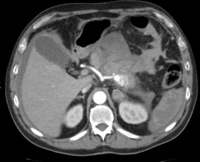Arterial Pseudoaneurysms Following Hepato-Pancreato-Biliary Surgery: A Single Center Experience
Abstract
Context Arterial pseudoaneurysm is an uncommon lethal complication following hepato-pancreato-biliary surgery. Objective Aim of this study is to present and discuss the experience of a high volume oncological center. Methods Since 2007 all major surgeries performed at Sanchinarro Oncological Center have been included in a prospective database looking for postoperative arterial pseudonaurysm. Results Until June 2014, among 559 hepato-pancreato-biliary procedures, a total of 14 arterial pseudoaneurysms have been identified (2.5%). Sentinel bleeding was in 57% of cases. Failed arterial embolization occurred in 2 cases. Overall mortality rate was 28.5%. We also identified 3 asymptomatic pseudoaneurysms, one of them managed without embolization, developing a sudden bleeding and died after surgery. Conclusions According to our experience, pseudoaneurysm incidence is higher than reported in current literature and it can be successfully managed through arterial embolization. Furthermore, we found 3 asymptomatic pseudoaneurysms, whose management is still controversial.
Image: Bleeding pseudoaneurysm at CT with arterial phase.
Downloads
References
Yekebas EF, Wolfram L, Cataldegirmen G, Habermann CR et al. Postpancreatectomy hemorrhage: diagnosis and treatment: an analysis in 1669 consecutive pancreatic resections. Ann Surg. 2007 Aug;246(2):269-80. [PMID: 17667506]
Miura F, Asano T, Amano H, Yoshida M et al. Management of postoperative arterial hemorrhage after pancreato-biliary surgery according to the site of bleeding: re-laparotomy or interventional radiology. J Hepatobiliary Pancreat Surg. 2009;16(1):56-63. [PMID: 19110653]
Pang TC, Maher R, Gananadha S, Hugh TJ, Samra JS. Peripancreatic pseudoaneurysms: a management-based classification system. Surg Endosc. 2014 Jul;28(7):2027-38. [PMID: 24519028]
Bassi C, Dervenis C, Butturini G, et al. Postoperative pancreatic fistula: an international study group (ISGPF) definition. Surgery. 2005; 138; 8-13 [PMID: 16003309]
Flati G, Andren-Sandberg A, La Pinta M et al. Potentially fatal bleeding in acute pancreatitis: pathophysiology, prevention, and treatment. Pancreas 26(1):8–14. [PMID: 12499910]
Tessier DJ, Fowl RJ, Stone WM, McKusick MA et al. Iatrogenic hepatic artery pseudoaneurysms: an uncommon complication after hepatic, biliary, and pancreatic procedures. Ann Vasc Surg. 2003 Nov;17(6):663-9. [PMID: 14564553]
Sugimoto H, Kaneko T, Ishiguchi T, Takai K et al. Delayed rupture of a pseudoaneurysm following pancreatoduodenectomy: report of a case. Surg Today. 2001;31(10):932-5. [PMID: 11759894]
Bergert H, Hinterseher I, Kersting S, Leonhardt J, Bloomenthal A, Saeger HD. Management and outcome of hemorrhage due to arterial pseudoaneurysms in pancreatitis. Surgery. 2005 Mar; 137(3):323-8. [PMID: 15746787]
Fujii Y, Shimada H, Endo I, Yoshida K et al. Management of massive arterial hemorrhage after pancreatobiliary surgery: does embolotherapy contribute to successful outcome? J Gastrointest Surg. 2007 Apr;11(4):432-8. [PMID: 17436126]
Christensen T, Matsuoka L, Heestand G, Palmer S et al. Iatrogenic pseudoaneurysms of the extrahepatic arterial vasculature: management and outcome. HPB (Oxford). 2006;8(6):458-64. [PMID: 18333102]
Suzumura K, Kuroda N, Kosaka H, Iimuro Y et al. Delayed arterial hemorrhage after pancreaticoduodenectomy. Int Surg. 2014 Jul-Aug;99(4):432-7. [PMID: 25058779]
Loveček M, Havlík R, Köcher M, Vomáčková K et al. Pseudoaneurysm of the gastroduodenal artery following pancreatoduodenectomy. Stenting for hemorrhage. Wideochir Inne Tech Malo Inwazyjne. 2014 Jun;9(2):297-301. [PMID: 25097705]
Lee HG, Heo JS, Choi SH, Choi DW. Management of bleeding from pseudoaneurysms following pancreaticoduodenectomy. World J Gastroenterol. 2010 Mar 14;16(10):1239-44. [PMID: 2839177]
Lermite E, Regenet N, Tuech JJ, Pessaux P et al. Diagnosis and treatment of hemosuccus pancreaticus: development of endovascular management. Pancreas. 2007 Mar;34(2):229-32. [PMID: 17312462]
Treckmann J, Paul A, Sotiropoulos GC, Lang H et al. Sentinel bleeding after pancreaticoduodenectomy: a disregarded sign. J Gastrointest Surg. 2008 Feb;12(2):313-8. [PMID: 17952516]
Sato N, Yamaguchi K, Shimizu S et al Coil embolization of bleeding visceral pseudoaneurysms following pancreatectomy: the importance of early angiography. Arch Surg 133(10):1099–1102. [PMID: 9790208]
Tajima Y, Kuroki T, Tsutsumi R, Sakamoto I et al. Extrahepatic collaterals and liver damage in embolotherapy for ruptured hepatic artery pseudoaneurysm following hepatobiliary pancreatic surgery. World J Gastroenterol. 2007 Jan 21;13(3):408-13. [PMID: 17230610]
Noun R, Zeidan S, Tohme-Noun C, Smayra T et al. Biliary ischemia following embolization of a pseudoaneurysm after pancreaticoduodenectomy. JOP. 2006 Jul 10;7(4):427-31. [PMID: 16832142]
Kaw LL Jr, Saeed M, Brunson M, Delaria GA et al. Use of a stent graft for bleeding hepatic artery pseudoaneurysm following pancreaticoduodenectomy. Asian J Surg. 2006 Oct;29(4):283-6. [PMID: 17098663]
Radeleff B, Noeldge G, Heye T, Schlieter M et al. Pseudoaneurysms of the common hepatic artery following pancreaticoduodenectomy: successful emergency embolization. Cardiovasc Intervent Radiol. 2007 Jan-Feb;30(1):129-32. [PMID: 16933158]

Copyright (c) 2015 Benedetto Ielpo, Riccardo Caruso, Antonio Presters, Giuseppe Massimiano De Luca, Hipolito Duran, Eduardo Diaz, Isabel Fabra, Sergio Olivares, Yolanda Quijano, Emilio Vicente

This work is licensed under a Creative Commons Attribution 4.0 International License.
As a member of Publisher International Linking Association, PILA, iMedPub Group’s JOP follows the Creative Commons Attribution License and Scholars Open Access publishing policies. Journal of the Pancreas is the Council Contributor Member of Council of Science Editors (CSE) and following the CSE slogan Education, Ethics, and Evidence for Editors.